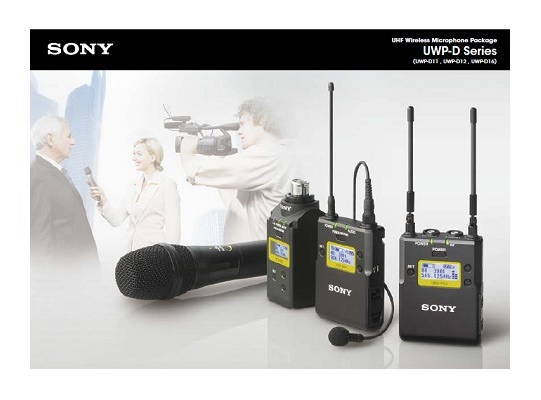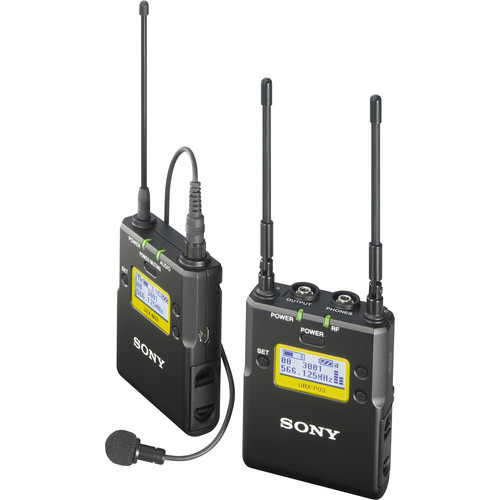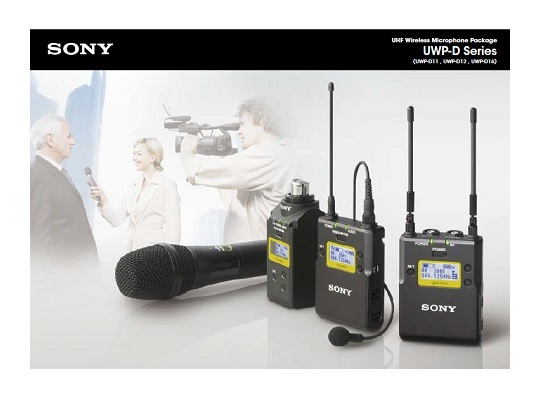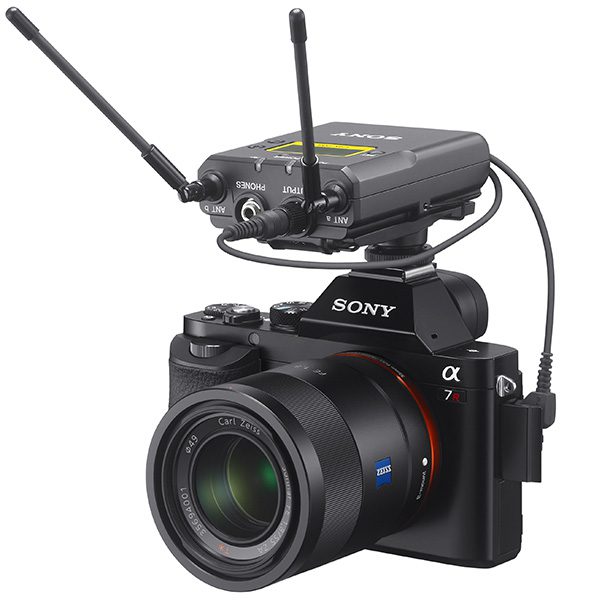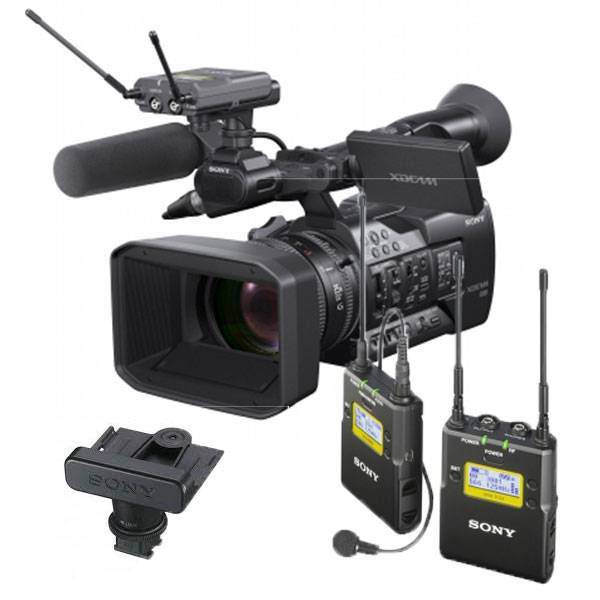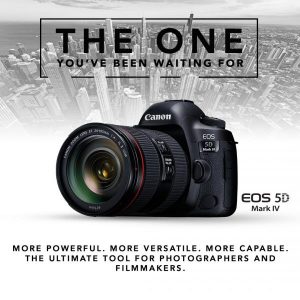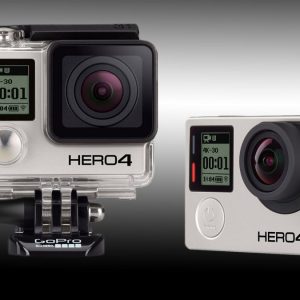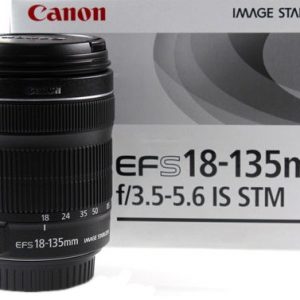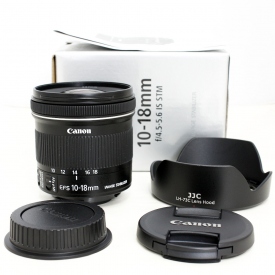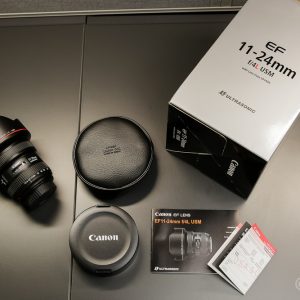Sony UWP-D11 Integrated Digital Wireless Bodypack Lavalier
Sony UWP-D11 Integrated Digital Wireless Bodypack Lavalier Microphone System (UHF Channels 30/36 and 38/41: 566 to 608 and 614 to 638 MHz)
The Sony UWP-D11 Camera-Mount Wireless Omni Lavalier Microphone System provides filmmakers, videographers, and journalists with a professional wireless system featuring digital audio processing for pristine sound and analog UHF transmission with true-diversity reception for reliability—even under difficult shooting conditions.
- UTX-B03 Bodypack Transmitter
- URX-P03 Portable True Diversity Receiver
- ECM-V1BMP Electret Condenser Lavalier
- Digital Companding Circuitry
- Selectable Mic/Line Input
- USB Charging and Power
- Tone Squelch Suppression Circuitry
- Automatic Channel Scanning
- Infrared Synchronization
- Simultaneous Multi-Channel Operation
Sony UWP-D11 Integrated Digital Wireless Bodypack Lavalier Microphone System
Sony UWP-D11/K33 Wireless Microphone
Belt-pack UWP-D wireless microphone package.
Digital Audio Processing for high quality sound for ENG / EFP productions
The UWP-D11 belt-pack wireless microphone package offers the sound quality of digital audio processing combined with the reliability of analogue FM modulation. The package includes the UTX-B03 belt-pack transmitter and URX-P03 portable receiver. Also included is a high quality omni-directional lavalier microphone and a range of accessories including windscreen, microphone holder clip, belt-clip and shoe-mount adaptor.The UWP-D11 package offers wide frequency coverage with up to 72 MHz bandwidth (depending on region) across a wide range of channels, with a choice of models to choose from. Easy-to-use features include a large display and small size receiver to fit neatly on any size camcorder or DSLR camera, automatic channel setting function, headphone output, USB connection for power supply and line input availability. The UWP-D Series system provides superb transient response performance for all ENG / EFP production applications.
Digital Audio Processing for high quality sound
Improves transient response performance between the UWP-D transmitter and receiver, which will provide impressive natural sound quality compared to conventional analogue wireless systems.
Complete package
The UWP-D11 comes as a complete package including the UTX-B03 belt-pack transmitter, URX-P03 portable receiver, omni-directional lavalier microphone and everything you need to operate the wireless audio system.
Wide frequency coverage with choice of channels available
The extra wide switching bandwidth covers a wide area, with a wide choice of channels available across multiple models – please refer to product specifications for more information.
Large display and small size receiver
The transmitter and receiver both feature a large display for ease of use, while the small size receiver fits neatly on any size camcorder or DSLR camera.
Easy to use features
Automatic channel setting function, headphone output, USB connection for power supply and line input availability.
UWP-D wireless microphones pick up Best of Show awards at IBC
Sony’s UWP-D wireless microphone series has scooped two accolades at this year’s IBC show. This light, compact wireless solution partners superb sound quality with smart features for versatile operation in the field. With the SMAD-P3 Multi Interface Shoe adaptor, you can enjoy cable-free connection between the wireless receiver and a range of Sony cameras and camcorders.
UWP-D Series is double award winner at IBC
After its successful debut at IBC 2014, Sony’s UWP-D wireless microphone family has been featured in the ‘Best of Show’ Award winners by leading European broadcast/media publications TVBEurope and Audio Media.
The ‘Best of Show’ Awards recognise outstanding products exhibited at the 2014 International Broadcasting Convention in Amsterdam. Winners were selected by panels of professional users and editors attending the show.
UWP-D Series wireless microphones team exceptionally reliable, stable signal transmission with the purity of Digital Sound Processing (DSP) for crystal-clear sound when you’re in the field. Quick and easy to set-up and adjust when you’re under pressure, UWP-D offers the extra attractions of long battery life in a tough, compact design that’s ideal for busy freelancers and solo camera operators.
Adding the SMAD-P3 shoe adaptor* allows audio signals to be transmitted directly from the URX-PO3 portable receiver to the camera with no XLR connecting cables. The adaptor connects the receiver securely to the Multi Interface (MI) terminal that features on several XDCAM camcorders, as well as Sony interchangeable lens cameras and pro-focused Handycam models.
As well as eliminating extra wires, the receiver draws power from the camera itself that also controls power ON/OFF. It’s a neat, integrated, highly practical audio solution for ENG, field production and DSLR-based film-makers alike.
* The SMAD-P3 MI shoe adaptor is compatible with PXW-X180/PXW-X160 portable XDCAM camcorders, α7/ α7R/ α7S/ α99 interchangeable lens digital cameras, Handycam NEX-VG900/NEX-VG30 camcorders and the Cyber-shot DSC-RX10 (as of July 2014).
Alister Chapman reviews the Sony UWP-D Digital Audio Processing Radio Mics:DoP and Cinematographer Alister Chapman shares his experience using the new UWP-D range of radio mics and how the clever new features combine together into an even smaller and neater package, giving improved dynamic range and natural sounding audio, even in remote locations.
Choosing the right microphone for the job –
For many years I have been happily using Sony’s previous generation UWP-V series radio microphones. These radio mics served me very well, getting carted all over the world from the Arizona Desert to Arctic Norway. They never let me down.
So really I was in no rush to replace them. However when I was shown some of the neat features of the new UWP-D range of radio mics, I decided to get the UWP-D11 kit. This comprises a belt pack transmitter with a lavalier microphone, and a belt pack receiver that comes with belt clips and a camera mounting bracket.
cameraman, I find microphones a pretty boring subject. But you know what? Audio is just as important as your pictures – some would say more important. Poor quality sound can really ruin an otherwise decent shot. Choosing the right microphone for the job is important: better still, bring in a sound recordist to look after the sound while you concentrate 100% on the pictures. Sadly however the reality on many of the shoots I’m involved with is that there isn’t the budget for a ‘soundie’. Nor is there the time or space to set up mic stands and fish poles with gun mics. What’s needed is something simple, quick and easy. This is where the ubiquitous radio mic comes into play.
No more cables to snag!
Being able to power the mic from the camera is hugely beneficial on longer shoots or in remote locations.
You can clip a lavalier (tie clip) mic on to your subject quickly and easily. There are no cables to snag, and if you want you can do walking/talking shots. I think most camera crews will own at least one radio mic kit.
But radio mics are traditionally a compromise. For years they have used old-fashioned FM radio to send the signal to the receiver… and this has a limited dynamic range and can be prone to noise and hiss. If your budget is big enough you can get around this with a pure digital radio mic system like Sony’s excellent DWX series. The DWX microphones use digital transmission to eliminate hiss. But much as I’d love a DWX system, for the type of work I do they are overkill.
So I wasn’t sure about the UWP-D concept – a hybrid digital mic that uses digital processing combined with traditional FM transmission. That is until I got to play with one.
Compact without sacrificing build quality
The first thing I noticed was the size. The UWP-D series is quite a bit smaller than previous generations without sacrificing build quality. They are made from rugged aluminium alloy. The next obvious thing is the size of the LCD display, it’s much larger, clearer and easier to read. It has a backlight on a timer so it’s easy to see even if you’re working in the dark. The other external differences are a little less obvious, but just as important.
On the bottom of the belt pack receiver there is a special new docking port that can be used to dock the microphone to an adapter for use with many of Sony’s video cameras. The docking port connects the receiver to a cradle. This then plugs in to the MI (Multi-Interface) Shoe that’s now present on a very wide range of Sony cameras, from the A7 DSLR’s to the consumer AX100 and the new XDCAM PXW series. When you use this cradle the mic is powered by the camera, and the audio passes directly to the camera via the adapter. No more cables to snag! Being able to power the mic from the camera is hugely beneficial on longer shoots or in remote locations.
If your camera doesn’t have an MI shoe then all is not lost, as next to the special docking port there is also a micro USB socket. You can use this socket to power the radio mic from almost any standard USB type power supply such as a phone charger. Many cameras have powered USB ports on them – or you can get D-Tap to USB adapters. So there are lots of ways to power these mics. The belt pack transmitter is the same: it too has a micro USB port that can be used to charge the mic’s batteries if you use NiMH rechargeables.
While I’m talking about the transmitter, it’s worth noting that this can be switched between mic and line level inputs. So if you need to take a remote feed from an audio desk you shouldn’t have any audio level issues – as can often be the case with transmitters that only accept mic level.
Clever features – A true diversity receiver that prevents audio dropouts
Back to the receiver. It’s a true diversity receiver with two antennas. Now, many radio mics have two antennas, but this one actually has two independent receiver sections. The unit automatically switches extremely rapidly to the receiver that’s getting the best signal. This prevents those annoying momentary audio dropouts that can occur in buildings due to signal reflections and other interference. On the top of the receiver there’s a locking 3.5mm jack for the main balanced output, and next to that is a secondary headphone output that could also be used to feed a second camera if needed.
The UWP-D radio mics have some clever features. The most useful to me is the ability to have the receiver scan for a clear and unused channel. Once it has found a clear channel it can set the frequency of the transmitter to match the receiver via infrared. This takes just moments to do, and is so much easier than messing around trying to manually enter channel numbers or frequencies. Once your frequency’s set, you can if you wish set the transmitter to a low power setting to make the batteries last longer. Although I do find that a set of good quality AA batteries will reliably give me a solid, non-stop half day’s use anyway.
Improved dynamic range resulting in natural sound
So what about the ‘D’ bit in the UWP-D name? To get decent quality sound from an FM radio mic the audio from the transmitter is compressed, making it possible to transmit a wide dynamic range over a single FM channel. Then in the receiver the audio is expanded to restore a natural sound range. This process is called a ‘compander’ (Compression Expander). Traditional systems do this with basic analogue circuits, but in the UWP-D series the compander is digital. This results in improved dynamic range, allowing the mic to better handle transient sounds like claps, clicks and pops. The audio just sounds more natural. I also find that I have less hiss from these mics than my previous ones.
On the surface the UWP-D may only seem like a small upgrade over the previous UWP-V series. But the improvements are many, and when combined together into this even smaller and neater package it makes them a worthwhile upgrade. Having used them for a little while now, I find them much more convenient and the audio really does sound better. I’m really pleased with them.
FEATURES:
- Sony Digital Audio Processing for high quality sound The UWP-D Series wireless microphone systems uses Digital Audio Processing to improve sound quality and transient response performance compared to conventional analogue wireless systems. It provides superb transient response performance. Analogue companding systems cannot accurately reproduce sounds such as a bell, tee shot or handclap, but Sony Digital Audio Processing reproduces them faithfully.
- Large display and small size receiver. The URX-P03 portable receiver is designed to fit even small camcorders or DSLR cameras, with dimensions of 63mm x 82mm x 23.8mm (W x H x D) and a weight of approx. 176 g (including batteries). The transmitters and receivers also feature a bright 11.5mm x 27.8mm display, significantly larger than previous UWP models to make them easily readable in all situations.
- Fast and easy channel scan. With its Clear Channel Scan, Active Channel Scan function and IR Sync features, the system detects unoccupied channels and selects the most appropriate channel automatically, for fast and easy system setup.
- Automatic channel setting mode. The Auto Set channel mode allows the user to find and set available frequencies to use within the operating frequencies of the system. The receiver will automatically set the transmitter channel using the IR Sync feature.
- Wide frequency coverage. The extra wide switching bandwidth covers a wide area, with a wide choice of channels available across four models. UWP-D11/K21 offers 72 MHz bandwidth across channels 21-29, UWP-D11/K33 offers 72 MHz bandwidth across channels 33-41, UWP-D11/K42 offers 56 MHz bandwidth across channels 42-48, and UWP-D11/K51 offers 72 MHz bandwidth across channels 51-59.
- True Diversity reception system. The UWP-D system achieves exceptionally stable audio signal being delivered from two independent receiver sections within the unit. Optimum signal quality is delivered by the two receivers sections and a comparison circuit constantly pulls the one with the best signal to give dropout free transmission.
- Compatibility with Sony 800 and UWP Series analogue audio receivers. The UWP-D Series transmitters and receivers are also compatible with Sonyメs WL-800 Series, UWP Series and Freedom Series, allowing users to switch between different companding modes.
- Headphone output for monitoring. The UWP-D system provides its own headphone output socket, which is particularly useful when working with a camera that does not have a headphone output.
- USB for external power supply or charging batteries. The UWP-D seriesメ components have a micro USB terminal* for connection to USB external portable power sources allowing the unit to be powered by the camcorder during use, resulting in hassle free power. You can also load NiMh batteries into the belt-pack to be charged through the micro USB.
* Except handheld receiver UTX-M03. - Robust metal body. The UTX-B03 belt-pack transmitter and URX-P03 portable receiver are made of strong, durable metal. Metal construction supports reliable use in rough operating conditions.
- Line Input available. The UWP-D Series system has line input available for added flexibility.
- Variable output level on portable receiver. The system provides variable output level control of ᄆ12dB, for use with the various input levels of camcorders and DSLR cameras.
- Complete package with accessories. The UWP-D11 package includes the UTX-B03 belt-pack transmitter and URX-P03 portable receiver, as well as: omni-directional lavalier microphone (1) , windscreen (1), microphone holder clip (1), belt clip (2), shoe-mount adaptor (1), 3-pole locking mini plug/XLR-3-12C (male) (1), 3-pole locking mini plug/Stereo mini plug (1), CD-ROM (1) (including operating instructions and wireless microphone frequency list).
Technical Specifications
Please be aware that the features/specifications can differ from country to country
| brands | Sony |
|---|---|
| color | Black |
| Condition |

